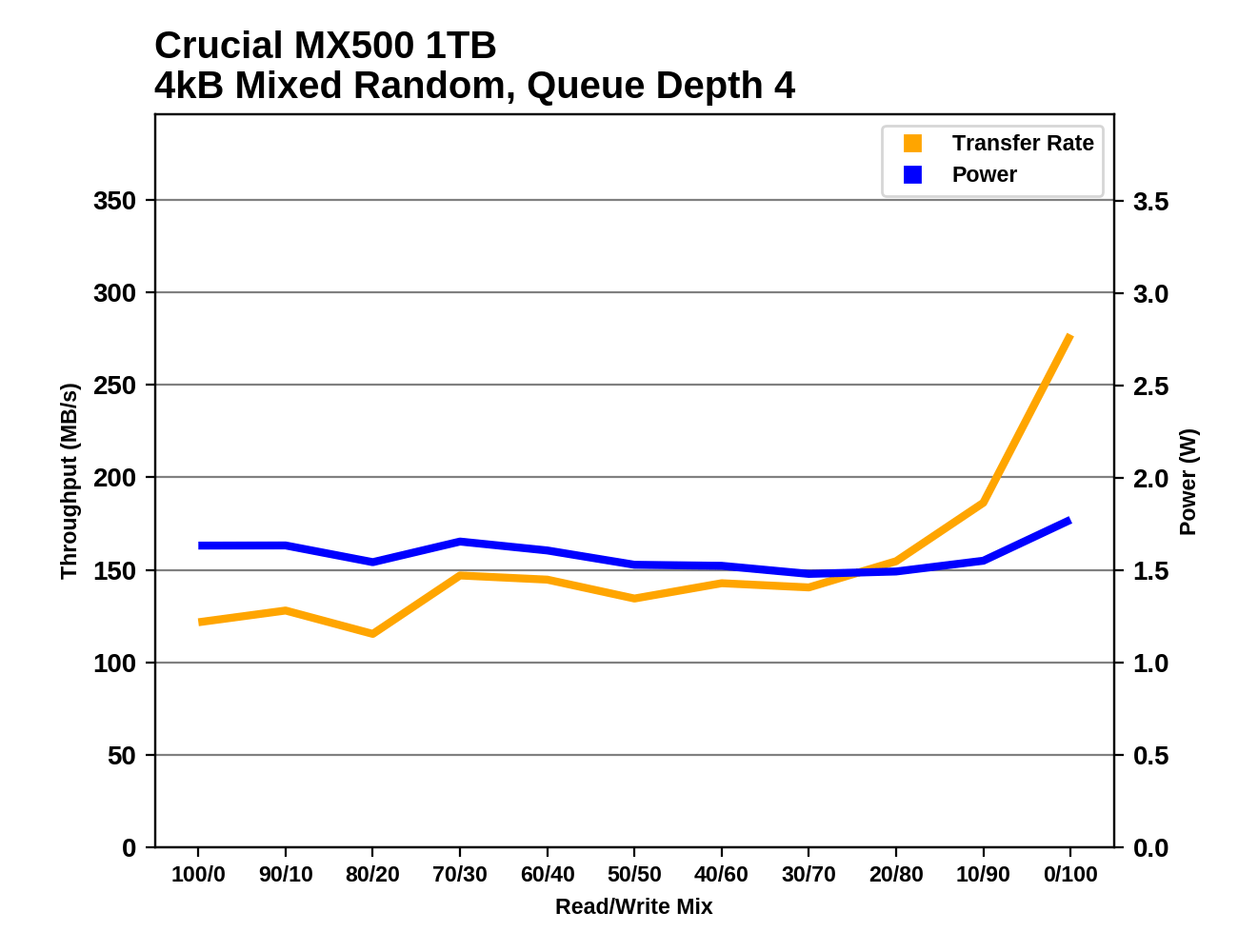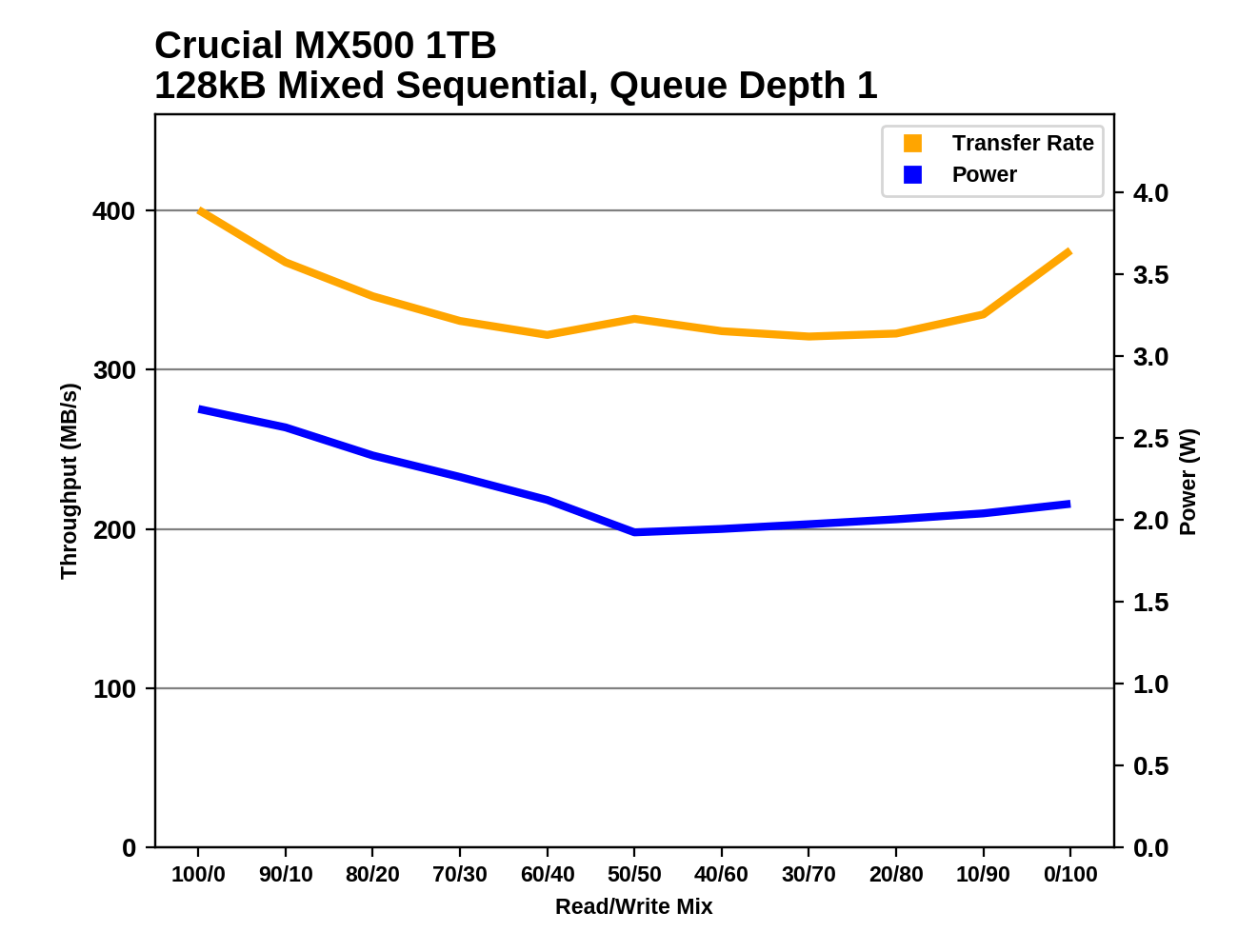The Crucial MX500 1TB SSD Review: Breaking The SATA Mold
by Billy Tallis on December 19, 2017 8:00 AM ESTMixed Random Performance
Our test of mixed random reads and writes covers mixes varying from pure reads to pure writes at 10% increments. Each mix is tested for up to 1 minute or 32GB of data transferred. The test is conducted with a queue depth of 4, and is limited to a 64GB span of the drive. In between each mix, the drive is given idle time of up to one minute so that the overall duty cycle is 50%.

The mixed random I/O performance of the Crucial MX500 is slightly slower than both the MX300 and the Intel 545s, but still above average for mainstream SATA SSDs. The 64L 3D TLC drives from Toshiba and Western Digital/SanDisk are significantly slower, and the Samsung 850 PRO and 850 EVO are still the fastest for this test.

The Crucial MX300 and Intel 545s are tied for first place for power efficiency on this test, with the MX500 coming in third place and well ahead of the other mainstream SATA drives.
 |
|||||||||
The Crucial MX500's performance during this test is a bit unsteady but generally good during the first half when the workload is more read-heavy. The MX500's speed picks up significantly when the workload becomes very write-heavy, but it take too long to start speeding up; other drives like the Samsung 850 PRO and EVO are steadily accelerating with increasing proportion of writes, starting fairly early in the test.
Mixed Sequential Performance
Our test of mixed sequential reads and writes differs from the mixed random I/O test by performing 128kB sequential accesses rather than 4kB accesses at random locations, and the sequential test is conducted at queue depth 1. The range of mixes tested is the same, and the timing and limits on data transfers are also the same as above.

The Samsung 850 PRO and EVO are the fastest SATA drives on the mixed sequential I/O test, and the Crucial MX500 falls into the second tier of drives, along with the other mainstream 64L 3D TLC drives and the MX300.

The Toshiba TR200 and OCZ VX500 score highest on power efficiency for the mixed sequential I/O test because they include little or no DRAM. The MX500 scores reasonably well overall but worse than the MX300 and the Intel 545s.
 |
|||||||||
The Crucial MX500 performs well in the early, read-heavy phases of the test but performance drops toward the middle and only recovers slightly at the end of the test. The minimum performance level across the entire test is quite high, but the fastest drives spend much less time performing at or near their minimum.










90 Comments
View All Comments
Flunk - Tuesday, December 19, 2017 - link
It's a shame they don't native compile it. The Oracle Java runtime is such a security problem I just don't have it installed on anything anymore.coder111 - Tuesday, December 19, 2017 - link
What on earth are you talking about? Don't install the browser plugin- no security problem. And get JDK, not JRE. Java language or runtime environment is not a security threat in any way. Browser plugin is, but it's been obsolete for more than a decade and only used for legacy applications, and shouldn't be used at all.Wolfpup - Tuesday, December 19, 2017 - link
I still don't want it on my system...but I'm sure I've updated firmware on Crucial drives without Java installed.smilingcrow - Tuesday, December 19, 2017 - link
Just uninstall after using the software as it's not as if you need to run an SSD utility frequently.Cooe - Wednesday, December 20, 2017 - link
Tin foil hat alert :)erple2 - Thursday, December 28, 2017 - link
Wait, what? Unless you're compiling Java applications, or trying to profile a running Java application and want to tune jvm settings, there's no real need anymore for the jdk. The jre is more than sufficient for the vast majority of needs. The days of the jre java.exe being subpar to java.exe included in the jdk died in the 1.6 days.mode_13h - Tuesday, December 19, 2017 - link
Traditionally, you can use the Micron enterprise tool with many of these drives. They caution against it, but it works fine in at least some cases - probably the MX drives are a good bet.HardwareDufus - Tuesday, December 19, 2017 - link
I have an OCZ-VERTEX4.. so I was looking at reviews here on AnandTech of my device to make a comparison. However, my drive was reviewed in 2012... when they used Desktop Iometer... which shows really high numbers....How do the newer testing methods at AnandTech differ from what they did in the past. Per these 2012 charts, my Vertex4 is faster.... but I know that's not the case after 5 years of progress...
mapesdhs - Saturday, December 23, 2017 - link
I've run AS-SSD, CDM, ATTO and HDTach on drives going back to the Vertex 4 (also 3, 2E, Agility 4 and Vector). I have some M.2 results to add to the archive, but here it is atm:http://www.sgidepot.co.uk/misc/ssdtests.zip
mapesdhs - Saturday, December 23, 2017 - link
Forgot to mention, the Vertex 4 is still a good drive. Just make sure the fw is up to date. Think the latest is 1.5.